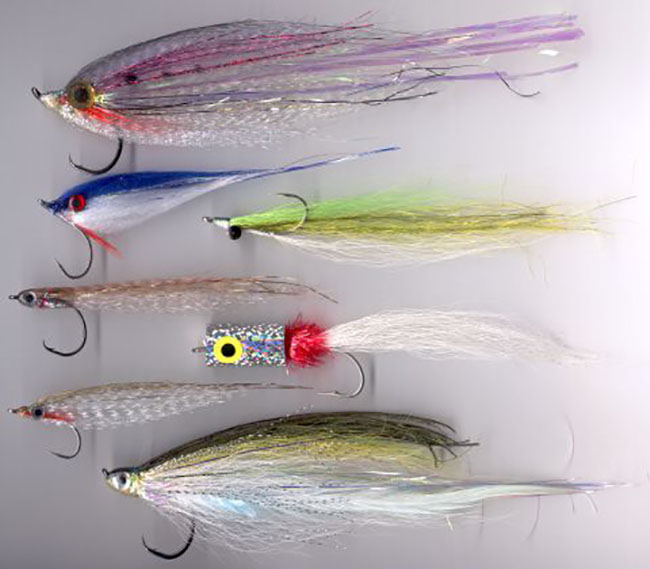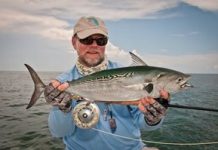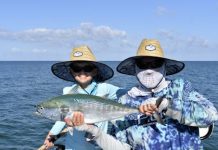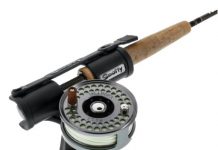By Pat Damico
While giving a saltwater fly fishing seminar at a fly shop in northeastern Pennsylvania this summer, I was asked this question, and it is one of the most frequently asked questions I hear. Dave Keck, the store’s owner, who I fished with for Smallmouth Bass on the Susquehanna River, five minutes from where we were in Berwick, PA, was close to me and I asked him to get out his fly box. Some flies did not have stainless steel hooks, but the flies we selected were all effective patterns to use in the Tampa Bay area where I do most of my fishing. This applies to most areas of Florida as well. Minnow imitations were most prevalent with hook size appropriate for snook, redfish and speckled trout, which are the most predominant quarry most of the year. Colors were also consistent with patterns that either “match the hatch” of local baitfish, or even imitate shrimp or small crabs.If you believe, as I do, that presentation is more important than color and size, his fly box would give you a good start if you ventured south for a few days of R&R with your fly rod.

It’s a growing passion with many a Florida angler — fly fishing in saltwater. Most are northern transplants who migrated to the Sunshine State bringing boxes filled with freshwater patterns. And the question on the minds of these fly flinging enthusiasts is, “Can I use my old favorites in this new saltwater environment?”
Using a combination of natural and synthetic materials, as well as size and weight variations, little else was needed. His predominant patterns were Clouser varieties, which Lefty Kreh has used to catch over 30 different saltwater species.
Not everyone uses stainless steel hooks, but a strong hook with the proper length and gap is very important. Few freshwater species will straighten or break a 1/0 hook. Lighter tippets in freshwater usually break before the fish has the opportunity to pull that hard. One of my first thumb-busting saltwater experiences was to get into a bait-terrorizing school of large Jack Crevalle. Fifty years of sweetwater fishing never prepared me for that experience.When structure is available, they will head for it and it is necessary to put on the pressure. Hook straightening or breaking can be the result.
Clouser Deep Minnows with different weight eyes: I tie some with plastic eyes, some half and half Clousers, Deceiver imitations and a few streamer patterns will give you a good start. Chartruse and white, and brown and orange, are my favorite combinations, but all white, and gray and white are also very good. Always have some black flies for poor visibility situations. Weedguards can be a good addition where grass or mangroves add another dimension of difficulty.
An article I wrote a while back on another fishing web site about small (juvenile) Tarpon elicited several questions about not only what flies to use, but how to use them effectively. Tarpon of any size seem to have their own agenda about what they like to eat at any given time.
According to Donald Larmouth and Rob Fordyce, authors of, Tarpon On Fly, juvenile Tarpon will eat almost anything you would throw at a Snook, size 2 or size 1/0 Lefty’s Deceivers, Glass Minnows, Sea-Ducers, Bend Backs, Clouser Deep Minnows, popping bugs, gurglers, divers, and the like. Downsized standard Tarpon patterns will also work.
Tarpon in some of the remote locations where they are pursued infrequently may never have seen an artificial lure, let alone a fly. Their willingness to take your offering can’t be compared to some of our fish that are challenged every day with not only lures, but live baits of every description. I know of several pods of small Tarpon that live in canals or harbors that seem impossible to catch with artificials. Most juvenile tarpon success seems to coincide with their being in a place that is a little distance from their usual haunts. Their reason for being there is the same as most species, the opportunity for an easy meal. Once you identify their food source, duplication will improve your chance for a hookup. I firmly believe that time spent in observation is never wasted, and in fact will shorten the time before you yell, fish on!
Remember to match the hatch. Size, color, shape, and action, when duplicated are essential whenever any fish is selective. A recent experience with small Tarpon had them chasing a school of baitfish in shallow water adjacent to their deeper home. A quick cast into the melee with a suitable presentation resulted in instant success.
Small Tarpon are usually not sight-fished like their bigger relatives. In the Keys, I have been able to stay with large schools of these fish because certain islands had a resident group that was nearby.
Once spotted rolling on the surface, a stealthy approach with judicious poling put us within casting range. Since water depth was four feet or less and very clear, their presence was not difficult to track.
Tarpon rolling on the surface allow you to pinpoint their location. Being there at the appearance of first light will be to your advantage. Most baby Tarpon I see rolling are in depths of 15 feet or more. This rolling activity is usually not associated with feeding, but rather with their air gulping movements.
In this situation, I feel their feeding activity is closer to the bottom rather than the top part of the water column. Tossing flies that are near the surface usually results in frustration. Using a sinking tip fly line with a sinking pattern will occasionally work, but finding fish in shallower water will insure your chances for success.
At higher tides, areas that hold Snook will frequently attract these fish. Mangrove shorelines, docks, points, bridge abutments, and any structure that will attract baitfish will put these fish in a more fly friendly mood. My success locally has always improved when I fished structure that was relatively shallow.
A strip, strip, strip, pause retrieve; similar to that used for large tarpon, will be a good starting place. Vary this if you get refusals or short strikes. Keep hooks sharp and use a shock tippet of 30-lb. test fluorocarbon. Remember to bow with each jump to prevent a straight line to the gyrating fish that usually results in hooks coming out.
The acrobatics of smaller Tarpon will put a big grin on any fly fisher’s face. I have had them land in the boat as well as in mangroves or branches of trees lying in the water. Once your efforts are rewarded, you will put this smaller Silver King at the top of your ‘Fun Fish’ list.
Don’t be in a big hurry to make your first cast. Look in the shallows to see what size and color baitfish are available and choose your fly accordingly. Watch how they move and you have a key as to how to retrieve. A slow moving fly will loose the interest of jacks, mackerel and barracuda, but most other species will turn on.
Always visit a local fly shop and ask questions. In addition to how to rig, and places to go, ask what patterns are most productive this time of year? If they are different than what you have, take at least one of each home with you to use as a guide for your next trip south.
Booking a guide, who is experienced in fly fishing, is always your best bet and investment for first timers. His experience will shorten your learning curve considerably and insure that you will have a lifetime of saltwater fever.
Captain Pat Damico
- Capiains Corner. Damico - December 26, 2023
- Pat Damico - December 21, 2023
- CaptainsCorner: Pat Damico - November 27, 2023











